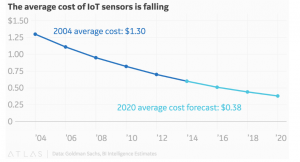If you are interested in going paperless, even if leadership has already decided to move forward, then the first step is to estimate the ROI of paperless manufacturing for the business. The ROI estimate not only increases support and vision upfront; it will help later to evaluate the success of the pilot program (See steps one and four, below).
- Estimate ROI
- Consider long-term technology stack implications
- Use Plant Readiness Assessment to select facility/area for pilot
- Deploy pilot to confirm ROI
- Develop full-scale rollout plan
- Go Paperless!
This blog itemizes all elements of paperless ROI, as well as areas where technological advancement has increased cost-effectiveness of going paperless, enabling smaller businesses to take large steps toward becoming Smart Manufacturers.
Going Paperless Requires Less Investment in Three Areas
IOT Sensors Less than Half the Price from 2004

The average price of sensors has more than halved since 2004, from $1.30, and is projected to dip to $0.38 by 2020.
RFID Alternatives for Manufacturers
Radio frequency identification (RFID) technology drives some of the largest process improvements on the factory floor. The technology can bring innovation and value when properly applied to manufacturing and warehousing. RFID uses electromagnetic fields to automatically identify and track tags attached to objects. The tags collect and electronically store specific information that stays with the product; down the production line, to the warehouse, and on to the customer. Manufacturers use RFID to tag raw materials, production statistics, inventory, and even people so that they can be tracked seamlessly across process steps, location, and time. For more information on implementing RFID
https://polytron.com/blog/rfid-implementation-delivers-product-tracking-inventory-control
Like sensors and barcoding, RFID prices are decreasing. Some alternatives for RFID recombine Bluetooth and barcode scanning to reach similar goals at a significantly reduced price point.
Cloud Solutions Drive Small Scale and Easy Integration
Another historical but outdated deterrent to going paperless has been software, as well as the cost of integrating comprehensive solutions between the factory floor and Enterprise Resource Planning (ERP). Cloud solutions have become easier to integrate, while also allowing businesses to scale based on need and usage.
Targeted Areas of Return on Going Paperless
Time
On average, manual writing takes twice as long to record as digital processes, but in some cases, where sensors and other automated identification can be used, the returns can be even greater. Estimate the time it takes for employees to enter data manually and/or input manual data into databases, spreadsheets, etc. Halve this number for a rough estimate of time savings. Use average factory floor salary to convert to a financial figure.
Accuracy
Inaccurate data can be another efficiency loss point for your organization, resulting in the need for product rework, or in the inability to make data-driven decisions. Automated workflow using RFID technology, for example, raises accuracy above 98% (Plant Engineering, May 2018).
Data Integration and Visualization
Going paperless increases accuracy and precision of tracking with real-time access to plant floor conditions. When data is instantly visible to managers, operators and MES systems, proven benefits such as improved product quality, optimized production efficiency, and supply chain integration are realized.
Historical Tracking Management
With paperless on the plant floor, historical production data is readily available for analytics and continuous improvement initiatives. How much time and effort does it take to store and retrieve critical production records that are manually-produced?
Read a Polytron case study for an end-to-end Track and Trace solution >>
Overall Equipment Effectiveness OEE & Downtime Tracking
Overall Equipment Effectiveness (OEE) measures the percentage of planned production time that is truly productive, accounting for three sources of real loss. Manual tracking systems can make reporting of these three areas of loss onerous and inaccurate.
Availability Loss
Events that cause planned production downtime for a significant amount of time, such as Planned and Unplanned Stops
Performance Loss
Factors causing a line to operate below maximum speed while still running, events described as Slow Cycles and Small Stops
Quality Loss
Products that do not meet or exceed quality standards and therefore require rework. Production Rejects and Reduced Yield on Startup are two examples.
Using digital tools to track availability, performance, and quality allows managers to understand conditions in real time and optimize performance much more effectively. Total Productive Maintenance (TPM) is a great example of an old protocol, which was onerous in 1999 but is now easier to implement.
Go Paperless, Next Steps
As a CSIA-Certified leader in engineering consulting and systems integration, Polytron has helped numerous global manufacturers automate outmoded data management process with digital systems to deliver real-time visibility for data-driven decisions.
How far has your business come on its Smart Manufacturing journey? Take the Polytron Smart Manufacturing Maturity Checklist to find out.



